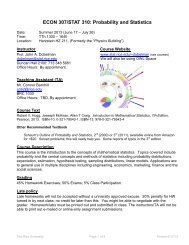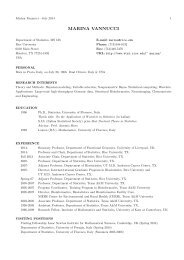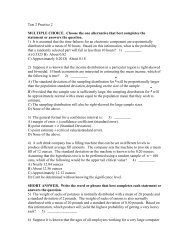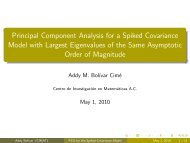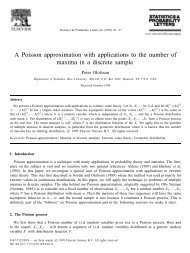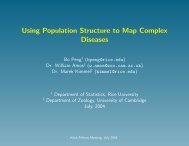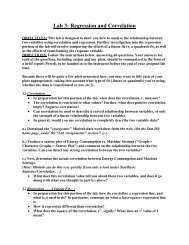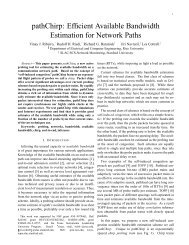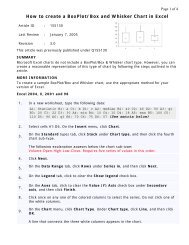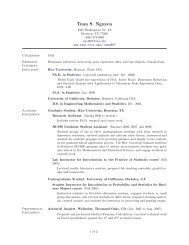Dimension Reduction Methods with Application to ... - Rice University
Dimension Reduction Methods with Application to ... - Rice University
Dimension Reduction Methods with Application to ... - Rice University
Create successful ePaper yourself
Turn your PDF publications into a flip-book with our unique Google optimized e-Paper software.
1 / 86<br />
<strong>Dimension</strong> <strong>Reduction</strong> <strong>Methods</strong> <strong>with</strong> <strong>Application</strong><br />
<strong>to</strong> High-dimensional Data <strong>with</strong> a Censored<br />
Response<br />
Tuan Nguyen<br />
under supervision of Javier Rojo<br />
Pan-American Statistics Institute<br />
May 1, 2010
SMALL n, LARGE p PROBLEM<br />
2 / 86<br />
◮ <strong>Dimension</strong> reduction<br />
◮ Motivation: Survival analysis using<br />
microarray gene expression data<br />
◮<br />
◮<br />
few patients, but 10-30K gene expression<br />
levels per patient<br />
patients’ survival times<br />
◮ Predict patient survival taking in<strong>to</strong><br />
account microarray gene expression data
OUTLINE<br />
3 / 86<br />
◮ Microarray Data<br />
◮ <strong>Dimension</strong> <strong>Reduction</strong> <strong>Methods</strong><br />
◮<br />
◮<br />
Random Projection<br />
Rank-based Partial Least Squares<br />
◮ <strong>Application</strong> <strong>to</strong> microarray data <strong>with</strong><br />
censored response<br />
◮ Conclusions
OUTLINE: OUR CONTRIBUTIONS<br />
4 / 86<br />
<strong>Dimension</strong> <strong>Reduction</strong> <strong>Methods</strong><br />
◮ Random Projection<br />
◮<br />
Improvements on the lower bound for k from<br />
Johnson-Lindenstrauss (JL) Lemma<br />
◮<br />
◮<br />
L 2 -L 2 : Gaussian and Achlioptas random matrices<br />
L 2 -L 1 : Gaussian and Achlioptas random matrices<br />
◮ Variant of Partial Least Squares (PLS):<br />
Rank-based PLS<br />
◮<br />
◮<br />
insensitive <strong>to</strong> outliers<br />
weight vec<strong>to</strong>rs as solution <strong>to</strong> optimization problem
OUTLINE<br />
◮ Microarray Data<br />
◮ <strong>Dimension</strong> <strong>Reduction</strong> <strong>Methods</strong><br />
◮ Small application<br />
◮ Conclusions<br />
5 / 86
DNA MICROARRAY<br />
◮ Traditional <strong>Methods</strong>: one gene, one<br />
experiment<br />
◮ DNA Microarray: thousands of genes<br />
in a single experiment<br />
◮<br />
◮<br />
Interactions among the genes<br />
Identification of gene sequences<br />
◮ Expression levels of genes<br />
6 / 86
WHAT IS DNA MICROARRAY?<br />
7 / 86<br />
◮ Medium for matching known and unknown DNA samples<br />
◮ Goal: derive an expression level of each gene (abundance<br />
of mRNA)<br />
Figure: Oligonucleotide array<br />
Figure: Oligonucleotide array
OLIGONUCLEOTIDE MICROARRAY<br />
Figure: Oligonucleotide Microarray 8 / 86<br />
◮ GeneChip (Affymetrix)<br />
◮ ∼30,000 sample spots<br />
◮ each gene is represented by more<br />
than 1 spots<br />
◮ thousands of genes on array<br />
◮ Hybridization Principle<br />
◮ glowing spots: gene expressed
OLIGONUCLEOTIDE MICROARRAY<br />
9 / 86<br />
◮ Intensity of each spot is scanned<br />
◮<br />
Expression level for each gene = <strong>to</strong>tal expression<br />
across all the spots<br />
◮ Multiple Samples: 1 array - 1 sample<br />
◮<br />
Matrix of gene expression levels<br />
X =<br />
⎛<br />
⎜<br />
⎝<br />
⎞<br />
X 11 X 12 . . . X 1p<br />
X 21 X 22 . . . X 2p<br />
⎟<br />
. . . . . . . . . . . . ⎠<br />
X N1 X N2 . . . X Np
SOME OTHER ARRAYS<br />
10 / 86<br />
◮ 1 flavor in past: Expression Arrays<br />
◮ Innovation: many flavors<br />
◮<br />
◮<br />
◮<br />
◮<br />
SNPs: single nucleotide polymorphisms <strong>with</strong>in or bet.<br />
populations<br />
Protein: interactions bet. protein-protein,<br />
protein-DNA/RNA, protein-drugs<br />
TMAs: comparative study bet. tissue samples<br />
Exon: alternative splicing and gene expression
APPLICATIONS OF MICROARRAY<br />
11 / 86<br />
◮ Gene discovery and disease diagnosis<br />
◮<br />
◮<br />
◮<br />
Functions of new genes<br />
Inter-relationships among the genes<br />
Identify genes involved in development of diseases<br />
◮ Analyses<br />
◮<br />
Gene selection, classification, clustering, prediction
DIFFICULTIES OF MICROARRAY<br />
12 / 86<br />
◮ thousands of genes, few samples<br />
(N ≪ p)<br />
◮ Survival Information<br />
◮ Observe the triple (X, T, δ)<br />
◮<br />
◮<br />
◮<br />
X = (x 1 , . . . , x p ) T gene expression<br />
data matrix<br />
Ti = min(y i , c i ) observed survival<br />
times (i = 1, . . . , N)<br />
δi = I(y i ≤ c i ) censoring indica<strong>to</strong>rs
ANALYZING MICROARRAY DATA<br />
13 / 86<br />
2-stage procedure:<br />
◮ 1) <strong>Dimension</strong> reduction methods<br />
M N x k = X N x p W p x k ,<br />
k < N ≪ p<br />
◮ 2) Regression model
OUTLINE: OUR CONTRIBUTIONS<br />
14 / 86<br />
<strong>Dimension</strong> <strong>Reduction</strong> <strong>Methods</strong><br />
◮ Random Projection<br />
◮<br />
Improvements on the lower bound for k from<br />
Johnson-Lindenstrauss (JL) Lemma<br />
◮<br />
◮<br />
L2 -L 2 : Gaussian and Achlioptas random matrices<br />
L2 -L 1 : Gaussian and Achlioptas random matrices<br />
◮ Variant of Partial Least Squares (PLS):<br />
Rank-based PLS
R k R d 15 / 86<br />
RANDOM PROJECTION (RP)<br />
he <strong>to</strong>pic of this lecture is dimensionality reduction. Many problems have been efficiently solved in low di<br />
ensions, but very often the solution <strong>to</strong> low-dimensional spaces are impractical for high dimensional spaces<br />
ecause either space running time is exponential in dimension. In order address the curse of dimen<br />
ionality,<br />
The<br />
one technique<br />
original<br />
is <strong>to</strong> map<br />
matrix<br />
a set ofX points<br />
is projected<br />
in a high dimensional<br />
on<strong>to</strong>space M by<br />
<strong>to</strong> another<br />
a<br />
set of points in<br />
low-dimensional randomspace matrix while allΓ,<br />
the important characterisitics of the data set are preserved. In this lec<br />
re, we will study Johnson Lindenstrauss Lemma. Essentially all the dimension reduction techniques via<br />
ndom projection rely on the Johnson Lindenstrauss Lemma.<br />
M N x k = X N x p Γ p x k (1)<br />
5.1 Johnson ◮ Johnson-Lindenstrauss Lemma<br />
(1984)<br />
◮ preserve pairwise dist. among the points (<strong>with</strong>in 1 ± ɛ)<br />
◮ k cannot be <strong>to</strong>o small<br />
he goal of Johnson Lindenstrauss Lemma is <strong>to</strong>, for a point set P in R d , find a point set Q in R k and<br />
mapping from P <strong>to</strong> Q, such that the pairwise distances of P are preserved (approximately) under the<br />
apping.
RP: JOHNSON-LINDENSTRAUSS (JL)<br />
LEMMA (1984)<br />
————————————————————————————<br />
Johnson-Lindenstrauss Lemma<br />
For any 0 < ɛ < 1 and integer n, let k = O(ln n/ɛ 2 ). For any set<br />
V of n points in R p , there is a linear map f : R p → R k such that<br />
for any u, v ∈ V,<br />
(1 − ɛ) ||u − v|| 2 ≤ ||f(u) − f(v)|| 2 ≤ (1 + ɛ) ||u − v|| 2 .<br />
————————————————————————————<br />
◮ n points in p−dimensional space can be projected on<strong>to</strong> a<br />
k−dimensional space such that the pairwise distance bet. any 2<br />
points is preserved <strong>with</strong>in (1 ± ɛ).<br />
◮ Euclidean distance in both original and projected spaces<br />
(L 2 -L 2 projection)<br />
◮ f is linear, but not specified<br />
16 / 86
JL LEMMA: IMPROVEMENT ON LOWER<br />
BOUND FOR k<br />
17 / 86<br />
for x = u − v ∈ R p<br />
◮ L 2 distance: ||x|| =<br />
√ ∑p<br />
j=1 x2 i<br />
◮ L 1 distance: ||x|| 1<br />
= ∑ p<br />
j=1 |x i|<br />
Γ is of dimension p by k<br />
◮ Frankl and Maehara (1988):<br />
k ≥<br />
⌈ ⌉ 27 ln n<br />
3ɛ 2 − 2ɛ 3 + 1 (2)<br />
◮ Indyk and Motwani (1998):<br />
◮ entries <strong>to</strong> Γ are i.i.d. N(0, 1)
JL LEMMA: IMPROVEMENT ON LOWER BOUND<br />
FOR k<br />
Compare<br />
————————————————————————————<br />
Dasgupta and Gupta (2003): mgf technique<br />
For any 0 < ɛ < 1 and integer n, let k be such that<br />
k ≥<br />
24 ln n<br />
3ɛ 2 − 2ɛ 3 . (3)<br />
For any set V of n points in R p , there is a linear map<br />
f : R p → R k such that for any u, v ∈ V,<br />
[<br />
P (1 − ɛ) ||u − v|| 2 ≤ ||f(u) − f(v)|| 2 ≤ (1 + ɛ) ||u − v|| 2] ≥ 1 − 2 n 2 .<br />
————————————————————————————<br />
◮ f(x) = 1 √<br />
k<br />
xΓ, where x = u − v<br />
◮ Gaussian random matrix:<br />
k ||f(x)||2<br />
||x|| 2<br />
◮ best available lower bound for k<br />
∼ χ 2 k<br />
18 / 86
JL LEMMA: DASGUPTA AND GUPTA<br />
19 / 86<br />
Considering the tail probabilities separately<br />
[<br />
P ||f(x)|| 2 ≥ (1 + ɛ) ||x|| 2] ≤ 1 n 2 , (4)<br />
[<br />
P ||f(x)|| 2 ≤ (1 − ɛ) ||x|| 2] ≤ 1 n 2 . (5)<br />
◮ f(x) = 1 √<br />
k<br />
xΓ, where x = u − v<br />
k ||f(x)||2<br />
||x|| 2 ∼ χ 2 k (6)<br />
◮ using mgf technique <strong>to</strong> bound the tail probabilities
JL LEMMA: DASGUPTA AND GUPTA<br />
20 / 86<br />
Sketch of Proof<br />
◮ define f(x) = 1 √<br />
k<br />
xΓ, and y = √ k f(x)<br />
||x||<br />
◮ Let y j = xr j<br />
||x|| ∼ N(0, 1), and y2 j ∼ χ 2 1 <strong>with</strong> E(||y|| 2 ) = k<br />
◮ Let α 1 = k(1 + ɛ), and α 2 = k(1 − ɛ), then
21 / 86<br />
JL LEMMA: DASGUPTA AND GUPTA<br />
Sketch of Proof<br />
◮ Right-tail prob:<br />
[<br />
P ||f(x)|| 2 ≥ (1 + ɛ) ||x|| 2] ]<br />
= P<br />
[||y|| 2 ≥ α 1<br />
( ( )) k<br />
≤ e −s(1+ɛ) E e sy2 j , s > 0<br />
= e −sα 1<br />
(1 − 2s) −k/2 , s ∈ (0, 1/2).<br />
◮ Left-tail prob:<br />
[<br />
P ||f(x)|| 2 ≤ (1 − ɛ) ||x|| 2] ]<br />
= P<br />
[||y|| 2 ≤ α 2<br />
( ( )) k<br />
≤ e s(1−ɛ) E e −sy2 j , s > 0<br />
= e sα 2<br />
(1 + 2s) −k/2<br />
≤ e −sα 1<br />
(1 − 2s) −k/2 , s ∈ (0, 1/2).
JL LEMMA: DASGUPTA AND GUPTA<br />
Sketch of Proof<br />
◮ Minimize e −s(1+ɛ) (1 − 2s) −1/2 wrt s, <strong>with</strong> s ∗ = 1 2<br />
]<br />
P<br />
[||y|| 2 ≥ α 1 ≤ exp<br />
(− k )<br />
2 (ɛ − ln(1 + ɛ)) (<br />
≤ exp − k<br />
)<br />
12 (3ɛ2 − 2ɛ 3 )<br />
( ɛ<br />
1+ɛ)<br />
,<br />
(7)<br />
◮ if k ≥<br />
and<br />
24 ln n<br />
, then<br />
3ɛ 2 −2ɛ 3<br />
P<br />
[<br />
||f(x)|| 2 ≥ (1 + ɛ) ||x|| 2] ≤ 1/n 2<br />
P<br />
[<br />
||f(x)|| 2 ≤ (1 − ɛ) ||x|| 2] ≤ 1/n 2 22 / 86
JL LEMMA<br />
Projection of all ( n<br />
2)<br />
pairs of distinct points<br />
◮ Results are given in terms of preserving distances between<br />
1 pair of points<br />
◮ lower bound for probability chosen <strong>to</strong> be 1 − 2/n<br />
2<br />
◮ Interest: simultaneously preserve distances<br />
among all ( n<br />
2<br />
)<br />
pairs of distinct points<br />
23 / 86
◮ prob. in Eq. (8) is bounded from below by 1 − 1/n β 24 / 86<br />
JL LEMMA<br />
Projection of all ( n<br />
2)<br />
pairs of distinct points<br />
{ ⋂<br />
P<br />
u,v∈V<br />
u≠v<br />
≥ 1 − ∑<br />
(1 − ɛ) ||u − v|| 2 ≤ ||f(u) − f(v)|| 2 ≤ (1 + ɛ) ||u − v|| 2 } (8)<br />
u,v∈V<br />
u≠v<br />
( n<br />
) 2<br />
≥ 1 −<br />
2 n 2 = 1 n .<br />
[ {(1<br />
P − ɛ) ||u − v|| 2 ≤ ||f(u) − f(v)|| 2 ≤ (1 + ɛ) ||u − v|| 2 } ] c<br />
◮ Introduce β > 0 (Achlioptas (2001)) so that for each pair<br />
u, v ∈ V,<br />
P<br />
[(1 ]<br />
− ɛ) ||u − v|| 2 ≤ ||f(u) − f(v)|| 2 ≤ (1 + ɛ) ||u − v|| 2<br />
≥ 1 − 2/n 2+β .
25 / 86<br />
IMPROVEMENT ON DASGUPTA AND<br />
GUPTA BOUND<br />
Rojo and Nguyen (2009a) (NR 1 Bound): k is smallest<br />
even integer satisfying<br />
( 1 + ɛ<br />
ɛ<br />
)<br />
g(k, ɛ) ≤ 1<br />
n 2+β (9)<br />
◮ g(k, ɛ) = e −λ 1<br />
λd−1 1<br />
(d−1)!<br />
is decreasing in k<br />
◮ λ 1 = k(1 + ɛ)/2 and d = k/2.<br />
◮ Gaussian random matrix<br />
◮ work directly <strong>with</strong> the exact distribution of<br />
where x = u − v<br />
◮ 12%-34% improvement<br />
k ||f(x)||2<br />
||x|| 2 ,
OUTLINE OF PROOF<br />
◮ Gamma-Poisson Relationship: Suppose X ∼ Gamma(d, 1), for<br />
d = 1, 2, 3, . . . , and Y ∼ Poisson(x), then<br />
P(X ≥ x) =<br />
∫ ∞<br />
◮ ||y|| 2 = ∑ k<br />
j=1 y2 j ∼ χ 2 k<br />
x<br />
1<br />
∑d−1<br />
Γ(d) zd−1 e −z x y e −x<br />
dz =<br />
y!<br />
y=0<br />
◮ Let d = k/2, α 1 = k(1 + ɛ), and α 2 = k(1 − ɛ), then,<br />
◮ Right tail prob.:<br />
◮ Left tail prob.:<br />
= P(Y ≤ d − 1)<br />
∫ ∞<br />
P[||y|| 2 1<br />
∑d−1<br />
≥ α 1 ] =<br />
α 1 /2 Γ(a) zd−1 e −z (α 1 /2) y e −α 1/2<br />
dz =<br />
y!<br />
y=0<br />
∫ α2<br />
P[||y|| 2 /2 1<br />
≤ α 2 ] =<br />
0 Γ(a) zd−1 e −z dz =<br />
∞∑ (α 2 /2) y e −α 2/2<br />
y=d<br />
y!<br />
(10)<br />
26 / 86
OUTLINE OF PROOF<br />
27 / 86<br />
Theorem 1: Given d as a positive integer<br />
a) Suppose 1 ≤ d < λ 1 , then<br />
∑d−1<br />
y=0<br />
b) Suppose 0 < λ 2 < d, then<br />
∞∑<br />
y=d<br />
λ y ( ) ( )<br />
1<br />
y! ≤ λ1 λ d−1<br />
1<br />
λ 1 − d (d − 1)!<br />
λ y ( ) (<br />
2<br />
y! ≤ λ2<br />
d − λ 2<br />
λ d−1<br />
2<br />
(d − 1)!<br />
)<br />
(11)<br />
(12)
IMPROVEMENT ON DASGUPTA AND<br />
GUPTA BOUND<br />
back<br />
Right-tail prob.<br />
∑d−1<br />
P[||y|| 2 ≥ α 1 ] = e −λ λ y 1 1<br />
y!<br />
y=0<br />
( ) ( )<br />
1 + ɛ λ d−1<br />
1<br />
≤<br />
e −λ 1 (13)<br />
ɛ (d − 1)!<br />
Left-tail prob.<br />
∞∑<br />
P[||y|| 2 ≤ α 2 ] = e −λ λ y 2 2<br />
y!<br />
y=d<br />
( ) ( )<br />
1 − ɛ λ d−1<br />
2<br />
≤<br />
ɛ (d − 1)!<br />
( ) ( )<br />
1 + ɛ λ d−1<br />
1<br />
≤<br />
ɛ (d − 1)!<br />
e −λ 2<br />
e −λ 1<br />
◮ lower bound for k:<br />
P[||y|| 2 ≥ α 1 ] + P[||y|| 2 ≤ α 2 ] ≤ 2e −λ 1<br />
( ) ( )<br />
1+ɛ λ d−1<br />
1<br />
≤ 2/n ɛ (d−1)!<br />
2+β 28 / 86
COMPARISON OF THE LOWER BOUNDS<br />
ON k<br />
Prob.<br />
29 / 86<br />
Table: L 2 -L 2 distance: NR 1 Bound, and DG Bound.<br />
N(0,1) entries NR 1 Bound DG Bound % Improv.<br />
n=10 ɛ = .1, β = 1 2058 2961 30<br />
ɛ = .3, β = 1 254 384 34<br />
ɛ = .1, β = 2 2962 3948 25<br />
ɛ = .3, β = 2 368 512 28<br />
n=50 ɛ = .1, β = 1 3976 5030 21<br />
ɛ = .3, β = 1 494 653 24<br />
ɛ = .1, β = 2 5572 6707 17<br />
ɛ = .3, β = 2 692 870 20<br />
n=100 ɛ = .1, β = 1 4822 5921 19<br />
ɛ = .3, β = 1 598 768 22<br />
ɛ = .1, β = 2 6716 7895 15<br />
ɛ = .3, β = 2 834 1024 19<br />
n=500 ɛ = .1, β = 1 6808 7991 15<br />
ɛ = .3, β = 1 846 1036 18<br />
ɛ = .1, β = 2 9390 10654 12<br />
ɛ = .3, β = 2 1168 1382 15
EXTENSION OF JL LEMMA TO L 1 NORM<br />
30 / 86<br />
◮ JL Lemma (L 2 -L 2 projection): space of original<br />
points in L 2 , and space of projected points in L 2 .<br />
◮ L 1 -L 1 Random Projection<br />
◮<br />
JL Lemma cannot be extended <strong>to</strong> the L 1 norm<br />
◮<br />
Charikar & Sahai (2002), Brinkman & Charikar<br />
(2003), Lee & Naor (2004), Indyk (2006)
OUTLINE: OUR CONTRIBUTIONS<br />
31 / 86<br />
<strong>Dimension</strong> <strong>Reduction</strong> <strong>Methods</strong><br />
◮ Random Projection<br />
◮<br />
Improvements on the lower bound for k from<br />
Johnson-Lindenstrauss (JL) Lemma<br />
◮<br />
◮<br />
L2 -L 2 : Gaussian and Achlioptas random matrices<br />
L2 -L 1 : Gaussian and Achlioptas random matrices<br />
◮ Variant of Partial Least Squares (PLS):<br />
Rank-based PLS
EXTENSION OF JL LEMMA TO L 1 NORM<br />
◮ L 2 -L 1 Random Projection: space of original<br />
points in L 2 , and space of projected points in L 1 .<br />
◮ Ailon & Chazelle (2006) and Ma<strong>to</strong>usek (2007)<br />
◮<br />
the original L 2 pair-wise distances are<br />
preserved <strong>with</strong>in (1 ± ɛ) √ 2/π of the<br />
projected L 1 distances <strong>with</strong> k,<br />
k ≥ Cɛ −2 (2 ln(1/δ)) (14)<br />
◮ δ ∈ (0, 1), ɛ ∈ (0, 1/2), C sufficiently large<br />
◮ when δ = 1/n 2+β , then k = O((4 + 2β) ln n/ɛ 2 )<br />
◮ sparse Gaussian random matrix (Ailon & Chazelle, and<br />
Ma<strong>to</strong>usek), sparse Achlioptas random matrix (Ma<strong>to</strong>usek)<br />
32 / 86
L 2 -L 1 RP: IMPROVEMENT TO AILON &<br />
CHAZELLE, AND MATOUSEK BOUND<br />
33 / 86<br />
Proof<br />
Ach<br />
Rojo and Nguyen (2009a) NR 2 Bound<br />
k ≥<br />
(2 + β) ln n<br />
− ln(A(s ∗ ɛ))<br />
(15)<br />
◮ A(s) = 2e −s√ 2/π(1+ɛ)+s 2 /2 Φ(s), s > 0<br />
◮ s ∗ ɛ is unique minimizer of A(s)<br />
◮ based on mgf technique<br />
◮ Gaussian and Achlioptas random matrix<br />
◮ 36%-40% improvement
34 / 86<br />
OUTLINE OF PROOF<br />
back<br />
◮ Define f(x) = 1 k xΓ,<br />
◮ Let y j = xr j<br />
||x||<br />
∼ N(0, 1), then E(||y||<br />
2<br />
1<br />
) = k √ 2/π and<br />
M |yj |(s) = 2e s2 /2 Φ(s), ∀s.<br />
◮ Let α 1 = k √ 2/π(1 + ɛ), and α 2 = k √ 2/π(1 − ɛ), then<br />
◮ Right tail prob.:<br />
◮ Left tail prob.:<br />
(<br />
P[||y|| 1 ≥ α 1 ] ≤ 2e −(sα 1/k)+(s 2 k<br />
Φ(s)) /2) , s > 0.<br />
(<br />
P[||y|| 1 ≤ α 2 ] ≤ 2e (sα 2/k)+(s 2 k /2) (1 − Φ(s)))<br />
, s > 0<br />
(<br />
≤ 2e −(sα 1/k)+(s 2 k<br />
Φ(s)) /2) , s > 0. (16)<br />
◮ Eq. (16) is obtained since e 2s√ 2/π <<br />
Φ(s)<br />
1−Φ(s) , s > 0.<br />
◮ minimize Eq. (16) wrt s, and plug s ∗ <strong>to</strong> get the bound.
COMPARISON OF THE LOWER BOUNDS<br />
ON k<br />
35 / 86<br />
Table: L 2 -L 1 distance: Ma<strong>to</strong>usek bound (C = 1), and NR 2<br />
Bound.<br />
N(0,1) entries Ma<strong>to</strong>usek NR 2 Bound % Improv.<br />
n=10 ɛ = .1, β = 1 1382 823 40<br />
ɛ = .3, β = 1 154 99 36<br />
ɛ = .1, β = 2 5527 3290 40<br />
ɛ = .3, β = 2 615 394 36<br />
n=50 ɛ = .1, β = 1 2348 1398 40<br />
ɛ = .3, β = 1 261 168 36<br />
ɛ = .1, β = 2 3130 1863 40<br />
ɛ = .3, β = 2 348 223 36<br />
n=100 ɛ = .1, β = 1 2764 1645 40<br />
ɛ = .3, β = 1 308 197 36<br />
ɛ = .1, β = 2 3685 2193 40<br />
ɛ = .3, β = 2 410 263 36<br />
n=500 ɛ = .1, β = 1 3729 2220 40<br />
ɛ = .3, β = 1 415 266 36<br />
ɛ = .1, β = 2 4972 2960 40<br />
ɛ = .3, β = 2 553 354 36
OUTLINE: OUR CONTRIBUTIONS<br />
36 / 86<br />
<strong>Dimension</strong> <strong>Reduction</strong> <strong>Methods</strong><br />
◮ Random Projection<br />
◮<br />
Improvements on the lower bound for k from<br />
Johnson-Lindenstrauss (JL) Lemma<br />
◮<br />
◮<br />
L2 -L 2 : Gaussian and Achlioptas random matrices<br />
L2 -L 1 : Gaussian and Achlioptas random matrices<br />
◮ Variant of Partial Least Squares (PLS):<br />
Rank-based PLS
ACHLIOPTAS-TYPED RANDOM<br />
MATRICES<br />
37 / 86<br />
◮ Achlioptas (2001): for q = 1 or q = 3<br />
⎧<br />
1<br />
r ij = √ ⎪⎨ +1 <strong>with</strong> prob.<br />
2q<br />
q 0 <strong>with</strong> prob. 1 − 1 (17)<br />
q<br />
⎪⎩<br />
1<br />
−1 <strong>with</strong> prob. . 2q<br />
◮ L 2 -L 2 projection<br />
◮ same lower bound for k as in the case of Gaussian random<br />
matrix<br />
(24 + 12β) ln n<br />
k ≥ . (18)<br />
3ɛ 2 − 2ɛ 3
ACHLIOPTAS<br />
38 / 86<br />
◮ Define f(x) = 1 √<br />
k<br />
xΓ, and y j = xr j<br />
||x|| 2<br />
◮ Goal: bound mgf of y 2 j<br />
◮ bounding the even moments of y j by the even moments in<br />
the case r ij ∼ N(0, 1)<br />
◮<br />
=⇒ mgf of y 2 j using r ij from Achlioptas proposal is<br />
bounded by mgf using r ij ∼ N(0, 1).
39 / 86<br />
L 2 -L 2 RP: IMPROVEMENT ON ACHLIOPTAS<br />
BOUND<br />
◮ Rademacher random matrix Eq. (17) <strong>with</strong> q = 1<br />
◮ r 2 ij = 1 and r lj r mj D = r ij independent<br />
Rojo and Nguyen (2009b)<br />
◮ Let y j = ∑ p<br />
i=1 c ir ij , <strong>with</strong> c i = x i<br />
||x|| 2<br />
, then<br />
k<br />
(<br />
||f(x)|| 2<br />
||x|| 2 )<br />
=<br />
k∑<br />
j=1<br />
y 2 j<br />
D<br />
= k + 2<br />
<strong>with</strong> c lm = c l c m , and r lmj = r lj r mj<br />
◮ 3 improvements on Achlioptas bound<br />
k∑<br />
j=1<br />
p∑<br />
p∑<br />
l=1 m=l+1<br />
c lm r lmj (19)
L 2 -L 2 RP: IMPROVEMENT ON ACHLIOPTAS<br />
BOUND<br />
Rojo and Nguyen (2009b): Method 1<br />
◮ Hoeffding’s inequality based on mgf<br />
———————————————————————<br />
Let U i ’s be independent and bounded random variables such that<br />
U i falls in the interval [a i , b i ] (i = 1, . . . , n) <strong>with</strong> prob. 1. Let<br />
S n = ∑ n<br />
i=1 U i, then for any t > 0,<br />
and<br />
P[S n − E(S n ) ≥ t] ≤ e −2t2 / ∑ n<br />
i=1 (b i−a i ) 2<br />
P[S n − E(S n ) ≤ t] ≤ e −2t2 / ∑ n<br />
i=1 (b i−a i ) 2<br />
———————————————————————<br />
◮ Method 1: lower bound for k<br />
( ) ( )<br />
(8 + 4β) ln n p − 1<br />
k ≥<br />
. (20)<br />
ɛ 2 p<br />
40 / 86
41 / 86<br />
OUTLINE OF PROOF<br />
◮ Right tail prob.:<br />
⎡<br />
p∑<br />
P[||y|| 2 ≥ k(1 + ɛ)] = P ⎣<br />
≤ exp<br />
j=1<br />
(<br />
−<br />
◮ Left tail prob.:<br />
⎡<br />
p∑<br />
P[||y|| 2 ≤ k(1 − ɛ)] = P ⎣<br />
≤ exp<br />
j=1<br />
(<br />
−<br />
p∑<br />
l=1 m=l+1<br />
⎤<br />
p∑<br />
c lm r lmj ≥ kɛ ⎦<br />
2<br />
)<br />
kɛ 2<br />
. (21)<br />
8 ∑ p<br />
l=1<br />
∑ p<br />
m=l+1 c2 l c2 m<br />
p∑<br />
l=1 m=l+1<br />
⎤<br />
p∑<br />
c lm r lmj ≤ − kɛ ⎦<br />
2<br />
)<br />
kɛ 2<br />
. (22)<br />
8 ∑ p<br />
l=1<br />
∑ p<br />
m=l+1 c2 l c2 m
42 / 86<br />
OUTLINE OF PROOF<br />
◮ ∑ p<br />
l=1<br />
∑ p<br />
m=l+1 c2 l c 2 m is max. at c l = c m = 1/p<br />
◮ Right tail prob.:<br />
◮ Left tail prob.:<br />
4<br />
p∑<br />
p∑<br />
l=1 m=l+1<br />
( ) p − 1<br />
c 2 l c 2 m ≤ 2<br />
p<br />
P[||y|| 2 ≥ k(1 + ɛ)] ≤ exp<br />
(− kɛ2<br />
4<br />
P[||y|| 2 ≤ k(1 − ɛ)] ≤ exp<br />
(− kɛ2<br />
4<br />
( )) p − 1<br />
p<br />
( )) p − 1<br />
p
43 / 86<br />
L 2 -L 2 RP: IMPROVEMENT ON ACHLIOPTAS<br />
BOUND<br />
Rojo and Nguyen (2009b): Method 2<br />
◮ Berry-Esseen inequality<br />
———————————————————————<br />
Let X 1 , . . . , X m be i.i.d. random variables <strong>with</strong> E(X i ) = 0,<br />
σ 2 = E(Xi 2) > 0, and ρ = E|X i| 3 < ∞. Also, let X¯<br />
m be the<br />
√<br />
sample mean, and F m the cdf of X¯<br />
m n/σ. Then for all x and m,<br />
there exists a positive constant C such that<br />
|F m (x) − Φ(x)| ≤ Cρ<br />
σ 3√ m<br />
———————————————————————<br />
◮ ρ/σ 3 = 1, and C = 0.7915 for ind. X i ’s (Siganov)<br />
◮ Method 2: lower bound for k: 10%-30% improvement<br />
1 − Φ<br />
( √<br />
ɛ<br />
kp<br />
2(p − 1)<br />
)<br />
+<br />
0.7915<br />
√<br />
kp(p − 1)/2<br />
≤ 1/n 2+β . (23)
L 2 -L 2 RP: IMPROVEMENT ON ACHLIOPTAS<br />
BOUND<br />
Rojo and Nguyen (2009b): Method 3<br />
◮ Pinelis inequality<br />
———————————————————————<br />
Let U i ’s be independent rademacher random variables. Let<br />
d 1 , . . . , d m be real numbers such that ∑ m<br />
i=1 d2 i = 1. Let<br />
S m = ∑ m<br />
i=1 d iU i , then for any t > 0,<br />
( )<br />
1<br />
P[|S m | ≥ t] ≤ min<br />
t , 2(1 − Φ(t − 1.495/t)) 2<br />
———————————————————————<br />
◮ Method 3: lower bound for k: 15% improvement (ɛ = 0.1)<br />
k ≥ 2(p − 1)a2 n<br />
pɛ 2 , (24)<br />
where a n = Qn+√ Q 2 n +4(1.495)<br />
2<br />
, and Q n = Φ −1 ( 1 − 1<br />
n 2+β )<br />
.<br />
44 / 86
COMPARISON OF THE LOWER BOUNDS<br />
ON k: RADEMACHER RANDOM MATRIX<br />
45 / 86<br />
Simulations<br />
Table: L 2 -L 2 distance <strong>with</strong> ɛ = 0.1: 1) Method 1 (based on Hoeffding’s<br />
inequality), 2) Method 2 (using Berry-Esseen inequality), 3) Method 3<br />
(based on Pinelis inequality), and 4) Achlioptas Bound (does not depend on<br />
p). Last column is the % improv. of Method 2 on Achlioptas Bound.<br />
β p Method 1 Method 3 Method 2 Achlioptas % Improv.<br />
n = 10 0.5 5000 2303 2045 1492 40<br />
10000 2303 2046 1492 2468 40<br />
n = 10 1 5000 2763 2472 1912 35<br />
10000 2763 2472 1911 2961 35<br />
n = 50 0.5 5000 3912 3553 3009 28<br />
10000 3912 3554 2995 4192 29<br />
n = 50 1 5000 4694 4300 3948 22<br />
10000 4694 4300 3821 5030 24<br />
n = 100 0.5 5000 4605 4214 3809 23<br />
10000 4605 4215 3715 4935 25<br />
n = 100 1 30000 5527 5100 4816 19<br />
70000 5527 5100 4623 5921 22
46 / 86<br />
L 2 -L 1 : ACHLIOPTAS RANDOM MATRIX<br />
Gaussian<br />
◮ same lower bound as in L 2 -L 1 case using Gaussian Random<br />
Matrix (NR 2 bound)<br />
◮ bounding the mgf of Achlioptas-typed r.v. by that of a<br />
standard Gaussian<br />
◮ 36%-40% improvement
SUMMARY<br />
Random Projection<br />
◮ Gaussian random matrix<br />
◮<br />
◮<br />
L 2 -L 2 projection: improvement of 12%-34% on<br />
Dasgupta and Gupta bound<br />
L 2 -L 1 projection: improvement of 36%-40% on<br />
Chazelle & Ailon bound<br />
◮ Achlioptas-typed random matrix<br />
◮<br />
◮<br />
L2 -L 2 projection: improvement of 20%-40% on<br />
Achlioptas bound (Rademacher random matrix)<br />
L 2 -L 1 projection: improvement of 36%-40% on<br />
Ma<strong>to</strong>usek bound<br />
◮ lower bound for k is still large for practical purposes: active<br />
research<br />
47 / 86
RP VS. PCA, PLS, . . .<br />
48 / 86<br />
Random Projection (RP)<br />
◮ criterion: preserve pairwise distance (<strong>with</strong>in 1 ± ɛ)<br />
◮ k is large<br />
PCA, PLS<br />
◮ optimization criterion
PRINCIPAL COMPONENT ANALYSIS<br />
(PCA)<br />
49 / 86<br />
◮ Karl Pearson (1901)<br />
———————————————————–<br />
◮ Variance optimization criteria,<br />
w k = arg max<br />
w ′ w=1<br />
Var(Xw) = arg max(N−1) −1 w ′ X ′ Xw<br />
w ′ w=1<br />
s.t. w ′ kX ′ Xw j = 0 for all 1 ≤ j < k.<br />
———————————————————-<br />
◮ ignores response y<br />
◮ eigenvalue decomposition of sample cov. matrix
PCA<br />
50 / 86<br />
◮ Sample covariance matrix S = (N − 1) −1 X ′ X<br />
◮ Eigenvalue decomposition: S = V∆V ′<br />
◮<br />
◮<br />
∆ = diag(λ 1 ≥ · · · ≥ λ N ) eigenvalues<br />
V = (v 1 , . . . , v N ) unit eigenvec<strong>to</strong>rs<br />
◮ weight vec<strong>to</strong>rs w k = v k<br />
◮ PCs are M k = Xw k , k = 1, . . . , N<br />
◮ Cumulative variation explained by the 1st K PCs<br />
is ∑ K<br />
k=1 λ k
PCA<br />
51 / 86<br />
How <strong>to</strong> Select K: number of PC’s<br />
◮ Proportion of Variation Explained<br />
◮ Cross-validation
52 / 86<br />
PARTIAL LEAST SQUARES (PLS)<br />
PCA<br />
◮ Herman Wold (1960)<br />
———————————————————–<br />
◮ Covariance optimization criteria,<br />
w k = arg max<br />
w ′ w=1<br />
Cov(Xw, y) = arg max(N − 1) −1 w ′ X ′ y<br />
w ′ w=1<br />
s.t. w ′ kX ′ Xw j = 0 for all 1 ≤ j < k.<br />
———————————————————-<br />
◮ incorporates both the covariates and response<br />
◮ ignores censoring
INCORPORATING CENSORING IN PLS<br />
53 / 86<br />
◮ Nguyen and Rocke (2002):<br />
◮<br />
◮<br />
◮<br />
PLS weights: wk = ∑ N<br />
i=1 θ ikv i , where v i eigenvec<strong>to</strong>rs<br />
of X ′ X<br />
θik depend on y only through a i = u ′ iy, where u i<br />
eigenvec<strong>to</strong>rs of XX ′<br />
a i is slope coeff. of simple linear regression of y on u i<br />
if X is centered.<br />
◮ Nguyen and Rocke: Modified PLS (MPLS)<br />
◮<br />
replace ai by slope coeff. from Cox PH regression of y<br />
on u i <strong>to</strong> incorporate censoring PLS
PLS: NONPARAMETRIC APPROACHES<br />
TO INCORPORATE CENSORING<br />
◮ Datta (2007):<br />
◮<br />
Reweighting: Inverse Probability of<br />
Censoring Weighted RWPLS<br />
◮ replace censored response <strong>with</strong> 0<br />
◮ reweigh the uncensored response by the inverse<br />
prob. that it corresponds <strong>to</strong> a censored obs.<br />
◮ Mean Imputation: MIPLS<br />
◮<br />
◮<br />
keep the uncensored response<br />
replace the censored response by its expected<br />
value given that the true survival time exceeds the<br />
censoring time<br />
54 / 86
OUTLINE: OUR CONTRIBUTIONS<br />
<strong>Dimension</strong> <strong>Reduction</strong> <strong>Methods</strong><br />
◮ Random Projection<br />
◮ Variant of Partial Least Squares (PLS):<br />
Rank-based PLS<br />
◮<br />
insensitive <strong>to</strong> outliers<br />
◮ weight vec<strong>to</strong>rs as solution <strong>to</strong> optimization problem<br />
55 / 86
NOTATIONS:<br />
56 / 86<br />
for vec<strong>to</strong>rs u = (u 1 , . . . , u n ) ′ and v = (v 1 , . . . , v n ) ′<br />
◮ Ranks of u i ’s: indices of positions in ascending or<br />
descending order<br />
◮ sample Pearson correlation coeff.<br />
∑ n<br />
i=1<br />
Cor(u, v) =<br />
(u i − ū)(v i − ¯v)<br />
√∑ n<br />
i=1 (u i − ū) 2√ ∑ n<br />
i=1 (v i − ¯v) 2<br />
◮ sample Spearman correlation coeff.: corr. on the ranks
NGUYEN AND ROJO (2009A, B):<br />
RANK-BASED PARTIAL LEAST<br />
SQUARES (RPLS)<br />
57 / 86<br />
◮ cov/corr. measure in PLS is influenced by<br />
outliers<br />
◮ replace Pearson corr. by Spearman rank corr.<br />
w k = arg max(N − 1) −1 w ′ R ′ XR y (25)<br />
w ′ w=1<br />
◮ use Nguyen and Rocke’s procedure (MPLS) and Datta’s<br />
RWPLS and MIPLS <strong>to</strong> incorporate censoring
RPLS: DERIVATION OF THE WEIGHTS<br />
58 / 86<br />
where<br />
<strong>with</strong> S j R X<br />
ζ’s obtained from<br />
w 1 =<br />
R′ X R y<br />
||R ′ X R y||<br />
(26)<br />
w k ∝ P k−1 w 1 , k ≥ 2 (27)<br />
P k−1 = I − ζ 1 S RX − ζ 2 S 2 R X<br />
− · · · − ζ k−1 S k−1<br />
R X<br />
(28)<br />
= S RX S RX . . . S<br />
} {{<br />
RX , S<br />
}<br />
RX = R ′ XR X , S X = X ′ X, and<br />
j times<br />
w ′ 1P k−1 S X w 1 = 0<br />
w ′ 1P k−1 S X w 2 = 0<br />
. . .<br />
w ′ 1P k−1 S X w k−1 = 0
OUTLINE<br />
◮ Microarray Data<br />
◮ <strong>Dimension</strong> <strong>Reduction</strong> <strong>Methods</strong><br />
◮ Small application <strong>to</strong> Microarray data<br />
<strong>with</strong> censored response<br />
◮ Conclusions<br />
59 / 86
60 / 86<br />
REAL DATASETS<br />
Simulations<br />
DLBCL<br />
Harvard<br />
Freq.<br />
0 20 60 100<br />
Freq.<br />
0 20 60 100<br />
0 20 40 60 80 100<br />
surv. times<br />
0 20 40 60 80 100<br />
surv. times<br />
Michigan<br />
Duke<br />
Freq.<br />
0 20 60 100<br />
Freq.<br />
0 20 60 100<br />
0 20 40 60 80 100<br />
surv. times<br />
0 20 40 60 80 100<br />
recur. times<br />
◮ Diffuse Large B-cell Lymphoma (DLBCL): 240 cases, 7399<br />
genes, 42.5% cens.<br />
◮ Harvard Lung Carcinoma: 84 cases, 12625 genes, 42.9% cens.<br />
◮ Michigan Lung Adenocarcinoma: 86 cases, 7129 genes,<br />
72.1% cens.<br />
◮ Duke Breast Cancer: 49 cases, 7129 genes, 69.4% cens.
SURVIVAL ANALYSIS<br />
61 / 86<br />
Cox Proportional Hazards (PH) Model<br />
h(t; z i , β) = h 0 (t)e z′ iβ<br />
(29)<br />
◮ h 0 : unspecified baseline hazard<br />
S(t; z i , β) = S 0 (t) ez′ i β (30)<br />
◮ incorporates the covariates and censored information<br />
◮ proportional hazards assumption
SURVIVAL ANALYSIS<br />
62 / 86<br />
Accelerated Failure Time (AFT) model<br />
◮ logarithm of true survival time<br />
log(y i ) = µ + X ′ iβ + σu i (31)<br />
◮ y i ’s are true survival times<br />
◮ µ and σ are location and scale parameters<br />
◮ u i ’s are the errors i.i.d. <strong>with</strong> some distribution
ASSESSMENT OF THE METHODS<br />
Selection of K<br />
1) K is fixed across all methods<br />
◮<br />
1 st K PCs explain a certain proportion of predic<strong>to</strong>r<br />
variability<br />
2) K is chosen by Cross-validation (CV)<br />
◮ K is inherent <strong>with</strong>in each method<br />
63 / 86
ASSESSMENT OF THE METHODS<br />
Selection of K by CV<br />
◮ Cox PH Model<br />
CV(surv.error) = 1<br />
sM<br />
s∑<br />
i=1 m=1<br />
M∑ ∑<br />
t∈D m<br />
[ˆ¯S −m (t) − ˆ¯S m (t)<br />
] 2<br />
◮<br />
◮<br />
◮<br />
◮<br />
◮<br />
i = 1, . . . , s is index of simulation<br />
m = 1, . . . , M is index for the fold<br />
Dm is the set of death times in m th fold<br />
ˆ¯S m denotes the est. surv. function for m th fold<br />
ˆ¯S −m denotes the est. surv. function when the m th fold is<br />
removed<br />
ˆ¯S m (t) = 1 ∑N m<br />
Ŝ m,n (t)<br />
N m<br />
ˆ¯S −m (t) = 1<br />
n=1<br />
N −m<br />
N −m<br />
∑<br />
Ŝ −m,n (t)<br />
n=1<br />
64 / 86
ASSESSMENT OF THE METHODS<br />
65 / 86<br />
Selection of K by CV<br />
◮ AFT Model<br />
CV(fit.error) = 1<br />
sM<br />
s∑<br />
⎡<br />
M∑<br />
⎢<br />
⎣<br />
i=1 m=1<br />
) 2<br />
⎤<br />
l=1 δ m,l(i)<br />
(ŷ ∗ m,l (i) − y∗ m,l (i) ⎥<br />
∑ Nm<br />
l=1 δ ⎦<br />
m,l(i)<br />
∑ Nm<br />
◮<br />
◮<br />
◮<br />
◮<br />
◮<br />
i = 1, . . . , s is index of simulation<br />
m = 1, . . . , M is index for the fold<br />
l = 1, . . . , Nm is index for the individual in m th fold<br />
y<br />
∗<br />
m,l<br />
(i) = ln (y m,l (i))<br />
ŷ∗<br />
m,l<br />
(i) are the estimates of y ∗ m,l (i)<br />
ŷ ∗ m,l(i) = ˆµ −m,AFT (i) + M m,l (i) ′ ˆβ−m,AFT (i)
PCA, MPLS, RWPLS, MIPLS, RMPLS<br />
◮ Principal Component Analysis (PCA):<br />
◮<br />
◮<br />
variance optimization criterion<br />
ignores response<br />
◮ Modified Partial Least Squares (MPLS), Reweighted PLS<br />
(RWPLS), and Mean Imputation PLS (MIPLS)<br />
◮<br />
◮<br />
cov/corr. optimization criterion<br />
incorporates the response and censoring<br />
◮ Proposed Method: Rank-based Partial Least Squares<br />
(RPLS)<br />
◮<br />
cov/corr. optimization criterion<br />
◮ incorporates the response and censoring; based on ranks<br />
66 / 86
67 / 86<br />
UNIV, SPCR, CPCR<br />
◮ Univariate Selection (UNIV): Bolvestad<br />
1. fit univariate regression model for each gene, and test null<br />
hypothesis β g = 0 vs. alternative β g ≠ 0<br />
2. arrange the genes according <strong>to</strong> increasing p-values<br />
3. pick out the <strong>to</strong>p K−ranked genes<br />
◮ Supervised Principal Component Regression (SPCR): Bair<br />
and Tibshirani<br />
1. use UNIV <strong>to</strong> pick out a subset of original genes<br />
2. apply PCA <strong>to</strong> the subsetted genes<br />
◮ Correlation Principal Component Regression (CPCR):<br />
Zhao and Sun<br />
1. use PCA but retain all PCs<br />
2. apply UNIV <strong>to</strong> pick out the <strong>to</strong>p K-ranked PCs
68 / 86<br />
REAL DATASETS<br />
Table: Cox model: DLBCL and Harvard datasets. K chosen by CV for the<br />
different methods. The min(CV(surv.error)) of the 1000 repeated runs are<br />
shown.<br />
DLBCL HARVARD<br />
Method K error K error<br />
PCA 7 0.1026 13 0.121<br />
MPLS 1 0.1076 1 0.1304<br />
RMPLS 1 0.1056 1 0.1124<br />
CPCR 2 0.1014 2 0.1402<br />
SPCR 1 0.1063 3 0.1473<br />
UNIV 11 0.1221 14 0.1663
69 / 86<br />
REAL DATASETS<br />
Table: AFT Lognormal Mixture model: DLBCL, Harvard, Michigan and<br />
Duke datasets. K chosen by CV for the different methods. The<br />
min(CV(fit.error)) of the 1000 repeated runs are shown.<br />
DLBCL HARVARD MICHIGAN DUKE<br />
Method K error K error K error K error<br />
PCA 5 5.33 6 1.43 4 4.14 4 19.15<br />
MPLS 3 2.56 1 0.51 3 1.04 1 15.91<br />
RMPLS 5 1.62 2 0.36 4 0.64 3 5.41<br />
RWPLS 1 5.54 1 1.35 1 4.90 1 13.11<br />
RRWPLS 1 5.32 1 2.06 1 4.07 2 9.60<br />
MIPLS 3 2.80 2 0.58 2 1.72 2 11.79<br />
RMIPLS 4 1.92 2 0.56 2 1.11 1 10.42<br />
CPCR 7 4.59 5 1.11 4 2.47 4 9.88<br />
SPCR 1 5.48 1 2.12 2 5.10 2 22.14<br />
UNIV 5 4.09 6 0.84 6 1.72 7 10.80
GENE RANKING<br />
70 / 86<br />
◮ Select significant genes<br />
◮<br />
Ranking of Genes: Absolute Value of the Estimated<br />
Weights on the Genes (AEW)<br />
AEW = |W ˆβ ∗ R| (32)<br />
◮<br />
where ˆβ ∗ R =<br />
ˆβ R<br />
se( ˆβ R )<br />
R denotes either Cox or AFT model
GENE RANKING<br />
71 / 86<br />
Table: Number of <strong>to</strong>p-ranked genes in common between the ranked versions<br />
of PLS and their un-ranked counterparts for DLBCL, Harvard, Michigan and<br />
Duke datasets using the absolute of the estimated weights for the genes for<br />
1st component. The first row shows the number of considered <strong>to</strong>p-ranked<br />
genes.<br />
K <strong>to</strong>p-ranked genes 25 50 100 250 500 1000<br />
DLBCL MPLS and RMPLS 15 33 74 188 397 802<br />
RWPLS and RRWPLS 0 0 1 32 140 405<br />
MIPLS and RMIPLS 18 36 76 201 409 843<br />
HARVARD MPLS and RMPLS 12 28 58 171 368 822<br />
RWPLS and RRWPLS 0 0 3 15 80 273<br />
MIPLS and RMIPLS 14 28 69 170 371 804<br />
MICHIGAN MPLS and RMPLS 10 20 46 117 273 601<br />
RWPLS and RRWPLS 0 0 0 2 20 126<br />
MIPLS and RMIPLS 0 0 1 12 45 158<br />
DUKE MPLS and RMPLS 3 3 3 21 73 210<br />
RWPLS and RRWPLS 0 3 7 36 105 287<br />
MIPLS and RMIPLS 0 0 2 18 59 194
ASSESSMENT OF THE METHODS<br />
72 / 86<br />
Simulation: Generating Gene Expression values<br />
x ∗ ij =<br />
◮ τ kj<br />
iid<br />
∼ N(µ τ , σ 2 τ )<br />
◮ ɛ ij ∼ N(µ ɛ , σ 2 ɛ )<br />
x ij = exp(x ∗ ij) (33)<br />
d∑<br />
r ki τ kj + ɛ ij , k = 1, . . . , d (34)<br />
k=1<br />
◮ r ki ∼ Unif (−0.2, 0.2) fixed for all simulations<br />
◮ d = 6, µ ɛ = 0, µ τ = 5/d, σ τ = 1, σ ɛ = 0.3<br />
◮ 5,000 simulations<br />
◮ p ∈ 100, 300, 500, 800, 1000, 1200, 1400, 1600<br />
◮ N = 50
SIMULATION SETUP<br />
73 / 86<br />
Simulation: Generating Survival Times<br />
◮ Cox PH model<br />
Exponential distribution<br />
y i = y 0i e −X′ i β<br />
c i = c 0i e −X′ i β<br />
y 0i ∼ Exp(λ y )<br />
c 0i ∼ Exp(λ c )<br />
Weibull distribution<br />
(<br />
y i = y 0i e<br />
−X i ′ β) 1/λ y<br />
(<br />
c i = c 0i e<br />
−X i ′ β) 1/λ c<br />
y 0i ∼ Weib(λ y , α y )<br />
c 0i ∼ Weib(λ c , α c )
SIMULATION SETUP<br />
74 / 86<br />
Simulation: Generating Survival Times<br />
◮ AFT model<br />
◮<br />
ln(y i ) = µ + X ′ iβ + u i and ln(c i ) = µ + X ′ iβ + w i<br />
◮<br />
◮<br />
log normal mixture:<br />
f ui (u) = 0.9φ(u) + 0.1φ(u/10)<br />
10<br />
exponential, lognormal, log-t<br />
◮ wi ∼ Gamma(a c , s c )
SIMULATION SETUP<br />
75 / 86<br />
Simulation: Generating Survival Times<br />
◮ both Cox and AFT models<br />
◮ observed surv. time T i = min(y i , c i )<br />
◮ censoring indica<strong>to</strong>r δi = I(y i < c i )<br />
◮ censoring rate P[y i < c i ]<br />
◮ β j ∼ N(0, σπ), 2 σ π = 0.2 for all p’s<br />
◮<br />
outliers in the response for large p
76 / 86<br />
PERFORMANCE MEASURES<br />
Performance Measures: once K is selected<br />
◮ Mean squared error of weights on the genes<br />
MSE(β) = 1 s<br />
s∑ p∑<br />
(β j − ˆβ j (i)) 2<br />
i=1 j=1<br />
◮<br />
ˆβ = W ˆβCox , AFT<br />
◮ AFT Model<br />
◮ Mean squared error of fit<br />
[<br />
s∑ ∑N ]<br />
n=1 δ n(i) (ŷ ∗ n(i) − y ∗ n(i)) 2<br />
MSE(fit) = 1 s<br />
i=1<br />
∑ N<br />
n=1 δ n(i)<br />
◮<br />
◮<br />
y<br />
∗<br />
n (i) = log (y n (i))<br />
ŷ∗ n (i) = ˆµ AFT (i) + M n (i) ′ ˆβAFT (i)
PERFORMANCE MEASURES<br />
Performance Measures:<br />
◮ Cox PH Model<br />
◮<br />
◮<br />
MSE of est. surv. function evaluated at the average of<br />
the covariates<br />
ave(d 2 ) = 1 s<br />
s∑ ∑<br />
i=1<br />
t∈D s<br />
(¯S i (t) − ˆ¯S i (t)<br />
MSE of est. surv. function evaluated using the<br />
covariates of each individual<br />
ave(d 2 .ind) = 1<br />
sN<br />
s∑<br />
N∑<br />
∑ (<br />
i=1 n=1 t∈D s<br />
) 2<br />
) 2<br />
S in (t) − Ŝ in (t)<br />
77 / 86
78 / 86<br />
SIMULATION RESULTS: COX MODEL, FIX K<br />
33% cens, 40% var<br />
33% cens, 70% var<br />
ave(d^2)<br />
0.0 0.5 1.0 1.5 2.0<br />
PCA<br />
MPLS<br />
RMPLS<br />
CPCR<br />
SPCR<br />
UNIV<br />
ave(d^2)<br />
0.0 0.5 1.0 1.5 2.0<br />
500 1000 1500<br />
number of genes<br />
500 1000 1500<br />
number of genes<br />
Cox model: 1/3 censored. MSE of est. surv. function evaluated at average of covariates<br />
(ave(d 2 )) for datasets <strong>with</strong> approximately 40% and 70% TVPE accounted by the first 3 PCs<br />
comparing PCA, PLS, MPLS, CPCR, SPCR, and UNIV.
79 / 86<br />
SIMULATION RESULTS: COX MODEL, FIX K<br />
33% cens, 40% var<br />
33% cens, 70% var<br />
ave(d^2.ind)<br />
0 1 2 3 4<br />
PCA<br />
MPLS<br />
RMPLS<br />
CPCR<br />
SPCR<br />
UNIV<br />
ave(d^2.ind)<br />
0 1 2 3 4<br />
500 1000 1500<br />
number of genes<br />
500 1000 1500<br />
number of genes<br />
Cox model: 1/3 censored. MSE of est. surv. function evaluated using the covariates of each<br />
individual (ave(d 2 .ind)) for datasets <strong>with</strong> approximately 40% and 70% TVPE accounted by<br />
the first 3 PCs comparing PCA, PLS, MPLS, CPCR, SPCR, and UNIV.
SIMULATION RESULTS: COX MODEL, CV<br />
min(CV(surv.error))<br />
ave(d^2)<br />
ave(d^2.ind)<br />
min(CV(surv.error))<br />
0.20 0.25 0.30 0.35 0.40<br />
PCA<br />
MPLS<br />
RMPLS<br />
CPCR<br />
SPCR<br />
UNIV<br />
500 1000 1500<br />
ave(d^2)<br />
0.0 0.5 1.0 1.5 2.0<br />
500 1000 1500<br />
ave(d^2.ind)<br />
1.0 1.5 2.0 2.5 3.0 3.5 4.0<br />
500 1000 1500<br />
number of genes<br />
number of genes<br />
number of genes<br />
Cox model: 1/3 censored. K is chosen by CV. Minimized CV of squared error of est. surv.<br />
function min(CV(surv.error)), MSE of est. surv. function evaluated at average of<br />
covariates (ave(d 2 )), and MSE of est. surv. function using the covariates of each individual<br />
(ave(d 2 .ind)) comparing PCA, MPLS, RMPLS, CPCR, SPCR, and UNIV.<br />
80 / 86
SIMULATION RESULTS: AFT MODEL, CV<br />
min(CV(fit.error))<br />
MSE(beta)<br />
MSE(fit)<br />
min(CV(fit.error))<br />
0 20 40 60 80 100<br />
RWPLS<br />
RRWPLS<br />
MIPLS<br />
RMIPLS<br />
MPLS<br />
RMPLS<br />
500 1000 1500<br />
number of genes<br />
MSE(beta)<br />
0 20 40 60 80<br />
500 1000 1500<br />
number of genes<br />
MSE(fit)<br />
10 20 30 40 50 60<br />
500 1000 1500<br />
number of genes<br />
min(CV(fit.error))<br />
MSE(beta)<br />
MSE(fit)<br />
min(CV(fit.error))<br />
0 20 40 60 80 100<br />
PCA<br />
MPLS<br />
RMPLS<br />
CPCR<br />
SPCR<br />
UNIV<br />
500 1000 1500<br />
number of genes<br />
MSE(beta)<br />
0 20 40 60 80<br />
500 1000 1500<br />
number of genes<br />
MSE(fit)<br />
10 20 30 40 50 60<br />
500 1000 1500<br />
number of genes<br />
Figure 1: AFT lognormal mixture model: 1/3 censored. K is chosen by CV. min(CV (fit.error)),<br />
MSE(β), and MSE(fit) comparing RWPLS, RRWPLS, MIPLS, RMIPLS, MPLS, and RMPLS (<strong>to</strong>p row),<br />
and comparing PCA, MPLS, RMPLS, SPCR, CPCR, and UNIV (bot<strong>to</strong>m row) based on 5000 simulations.<br />
81 / 86
SIMULATION RESULTS: AFT MODEL, CV<br />
min(CV(fit.error))<br />
MSE(beta)<br />
MSE(fit)<br />
min(CV(fit.error))<br />
0 50 100 150<br />
RWPLS<br />
RRWPLS<br />
MIPLS<br />
RMIPLS<br />
MPLS<br />
RMPLS<br />
MSE(beta)<br />
0 20 40 60 80<br />
MSE(fit)<br />
10 20 30 40 50 60 70<br />
500 1000 1500<br />
500 1000 1500<br />
500 1000 1500<br />
number of genes<br />
number of genes<br />
number of genes<br />
min(CV(fit.error))<br />
MSE(beta)<br />
MSE(fit)<br />
min(CV(fit.error))<br />
0 50 100 150<br />
PCA<br />
MPLS<br />
RMPLS<br />
CPCR<br />
SPCR<br />
UNIV<br />
MSE(beta)<br />
0 20 40 60 80<br />
MSE(fit)<br />
10 20 30 40 50 60 70<br />
500 1000 1500<br />
500 1000 1500<br />
500 1000 1500<br />
number of genes<br />
number of genes<br />
number of genes<br />
Figure: AFT exponential model: 1/3 censored. K is chosen by CV based on<br />
5000 simulations.<br />
82 / 86
SUMMARY<br />
83 / 86<br />
◮ Rank-based Partial Least Squares (RPLS)<br />
◮<br />
◮<br />
replace Pearson correlation <strong>with</strong> Spearman rank<br />
correlation<br />
incorporate censoring: Nguyen and Rocke’s MPLS,<br />
Datta’s RWPLS and MIPLS<br />
◮ Rank-based Partial Least Squares (RPLS) works well<br />
◮<br />
◮<br />
in presence of outliers in response<br />
comparable <strong>to</strong> MPLS and PCA in absence of outliers<br />
Outlook
CONCLUSIONS<br />
84 / 86<br />
<strong>Dimension</strong> reduction methods<br />
◮ Random Projection<br />
◮<br />
◮<br />
Johnson-Lindenstrauss (JL) Lemma<br />
Improvements on the lower bound for k<br />
◮<br />
◮<br />
L 2 -L 2 : Gaussian and Achlioptas-type random<br />
matrices<br />
L2 -L 1 : Gaussian and Achlioptas-type random<br />
matrices<br />
◮ Rank-based Partial Least Squares (RPLS)<br />
◮<br />
competitive dimension reduction method
THANK YOU!<br />
85 / 86<br />
Special Thanks:<br />
Dr. Rojo, Chair and Advisor, Professor of<br />
Statistics, <strong>Rice</strong> <strong>University</strong>
ACKNOWLEDGMENT<br />
86 / 86<br />
This work is supported by:<br />
NSF Grant SES-0532346, NSA RUSIS Grant<br />
H98230-06-1-0099, and NSF REU Grant<br />
MS-0552590
DATTA: REWEIGHTING (RWPLS)<br />
87 / 86<br />
◮ Kaplan-Meier estima<strong>to</strong>r<br />
Ŝ c (t) = ∏ t i ≤t<br />
[<br />
1 − c i<br />
n i<br />
]<br />
where t 1 < · · · < t m are ordered cens. times, c i = no. cens.<br />
observations, n i = no. still alive at time t i<br />
◮ Let ỹ i = 0 for δ i = 0 and ỹ i = T i /Ŝ c (T − i ) for<br />
δ i = 1<br />
◮ apply PLS <strong>to</strong> (X, ỹ)<br />
back
DATTA: MEAN IMPUTATION (MIPLS)<br />
88 / 86<br />
◮ Conditional expectation<br />
∑<br />
y ∗ t<br />
=<br />
j >c i<br />
t j ∆Ŝ(t j )<br />
Ŝ(c i )<br />
where t j are ordered death times, ∆Ŝ(t j ) is jump size of Ŝ at<br />
t j , n i = no. still alive at time t i<br />
◮ Let ỹ i = y i for δ i = 1 and ỹ i = y ∗ i for δ i = 0<br />
◮ apply PLS <strong>to</strong> (X, ỹ)<br />
back
89 / 86<br />
BIBLIOGRAPHY<br />
◮ Achlioptas, D. Database-friendly random projections. Proc. ACM Symp. on the principles of database systems, 2001.<br />
pp. 274-281.<br />
◮ Alizadeh, A.A., Eisen, M.B., Davis, R.E., Ma, C., Lossos, I.S., Rosenwald, A., Broldrick, J.C., Sabet, H., Tran, T., and<br />
Yu, X. Distinct types of diffuse large B-cell lymphoma identified by gene expression profiling. Nature, 403, 2000. pp.<br />
503-511.<br />
◮ Bair, E., Hastie, T., and Tibshirani, R. Prediction by supervised principal components. Journal of American Statistical<br />
Association 101. 2006. pp. 119-137.<br />
◮ Bovelstad, H.M., Nygard, S., S<strong>to</strong>rvold, H.L., Aldrin, M., Borgan, O., Frigessi, A., and Lingjaerde, O.C. Predicting<br />
survival from microarray data - a comparative study. Bioinformatics Advanced Access 2007.<br />
◮ Cox, D.R. Regression Models and life tables (<strong>with</strong> discussion). Statistical Society Series B34, 1972. pp. 187.<br />
◮ Dai, J.J., Lieu, L., and Rocke, D.M. <strong>Dimension</strong> reduction for classification <strong>with</strong> gene expression microarray data.<br />
Statistical <strong>Application</strong>s in Genetics and Molecular Biology, vol. 5, issue 1, article 6, 2006.<br />
◮ Dasgupta, S. and Gupta, A. An elementary proof of the Johson- Lindenstrauss lemma. Technical report 99-006, UC<br />
Berkeley, March 1999.<br />
◮ Datta, S., Le Rademacher, J., and Datta, S. Predicting patient survival by accelerated failure time modeling using<br />
partial least squares and lasso. Biometrics 63, 2007. pp. 259-271.<br />
◮ Johnson, W. and Lindenstrauss, J. Extensions of Lipschitz maps in<strong>to</strong> a Hilbert space. Contemp. Math. 26, 1984, pp.<br />
189-206.<br />
◮ Kaplan E.L., and Meier, P. Nonparametric estimation from incomplete observations. Journal of American Statistics<br />
Association 53, 1958. pp. 467-481.<br />
◮ Klein, J.P., and Moeschberger, M.L. Survival Analysis: techniques for censored and truncated data. Springer, second<br />
edition. New York, 2003.<br />
◮ Kohonen, T. et al. Self organization of massive document collection. IEEE Transactions on Neural Networks, 11 (3),<br />
May 2000. pp. 574-585.
90 / 86<br />
BIBLIOGRAPHY<br />
◮ Li, K.C., Wang, J.L., and Chen C.H. <strong>Dimension</strong> reduction for censored regression data. The Annals of Statistics 27,<br />
1999. pp. 1-23.<br />
◮ Li, L. and Li, H. <strong>Dimension</strong> reduction methods for microarrays <strong>with</strong> application <strong>to</strong> censored survival data. Center for<br />
Bioinformatics and Molecular Biostatistics, Paper surv2, 2004.<br />
◮ Li, P., Hastie, T.J., and Church K.W. Very Sparse Random Projections. Proceedings of the 12th ACM SIGKDD<br />
international conference on knowledge discovery and data mining, 2006. pp. 287-296.<br />
◮ Mardia, K.V., Kent, J.T., and Bibby, J.M. Multivariate Analysis. Academic Press, 2003.<br />
◮ Nguyen, D.V. and Rocke, D.M. Assessing patient survival using microarray gene expression data via partial least<br />
squares proportional hazard regression. Computational Science Statistics, 33, 2001. pp. 376.<br />
◮ Nguyen, D.V. and Rocke, D.M. Partial least squares proportional hazard regression for application <strong>to</strong> DNA microarray<br />
survival data. Bioinformatics, 18, 1625, 2002.<br />
◮ Nguyen, D.V. Partial least squares dimension reduction for microarray gene expression data <strong>with</strong> a censored response.<br />
Mathematical Biosciences, 193, 2005. pp. 119-137.<br />
◮ Nguyen TS, Rojo J, <strong>Dimension</strong> reduction of microarray data in the presence of a censored survival response: a<br />
simulation study, Statistical <strong>Application</strong>s in Genetics and Molecular Biology 8.1.4, 2009.<br />
◮ Nguyen TS, Rojo J, <strong>Dimension</strong> reduction of microarray gene expression data: the accelerated failure time model,<br />
Journal of Bioinformatics and Computational Biology, 7.6, 2009. pp. 939-954.<br />
◮ Rojo J, Nguyen TS, Improving the Johnson-Lindenstrauss Lemma, Journal of Computer and System Sciences.<br />
Submitted, 2009.<br />
◮ Rojo J, Nguyen TS, Improving the Achlioptas bound for Rademacher random matrices. In Preparation, 2009.<br />
◮ Sun, J. Correlation principal component regression analysis of NIR data. Journal of Chemometrics, 9, 1995. pp. 21-29.<br />
◮ Wold, H. Estimation of principal components and related models by iterative least squares. In Krishnaiah, P. (ed.),<br />
Multivariate Analysis. Academic Press, N.Y., 1966. pp. 391-420.<br />
◮ Zhao, Q., and Sun, J. Cox survival analysis of microarray gene expression data using correlation principal component<br />
regression. statistical applications in genetics and molecular biology vol.6.1, article 16. Berkeley Electronic Press,<br />
2007.




